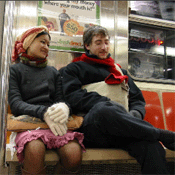webwork 5
Stop Motion Studies
by David CRAWFORD (United States), 2002-2004
 Stop Motion Studies - Series 7 is an internet-based work remix1 comprised of video clips of subway stations and subway car interiors.
Most clips reveal people sitting or standing while traveling.
Perhaps striking is how similar the images are among the four cities represented in this remix. Clips are arranged in four sections: Boston, New York, London, and Paris. Each section has an index of segments shot in that city. Viewers can peruse the list of descriptive file names, and then choose from that list. Clips then upload to the spot designated for that city. One is reminded of the Mike Figgis film Timecode (2000), also shot in digital video. Timecode employs four narrative trajectories recorded simultaneously in real time. The four interrelated segments are displayed in a 2 x 2 grid - like Crawford's piece. But in Timecode the four linear stories unfold simultaneously over the course of ninety-seven minutes.
Stop Motion Studies - Series 7 is an internet-based work remix1 comprised of video clips of subway stations and subway car interiors.
Most clips reveal people sitting or standing while traveling.
Perhaps striking is how similar the images are among the four cities represented in this remix. Clips are arranged in four sections: Boston, New York, London, and Paris. Each section has an index of segments shot in that city. Viewers can peruse the list of descriptive file names, and then choose from that list. Clips then upload to the spot designated for that city. One is reminded of the Mike Figgis film Timecode (2000), also shot in digital video. Timecode employs four narrative trajectories recorded simultaneously in real time. The four interrelated segments are displayed in a 2 x 2 grid - like Crawford's piece. But in Timecode the four linear stories unfold simultaneously over the course of ninety-seven minutes.
Crawford describes Stop Motion Studies as a reflection of his "long-standing interest in narrative" and a "look at the subway as a stage upon which social dynamics and individual behavior are increasingly mediated by digital technology." One could contemplate the work as a narrative, an ethnographic study, a database, or an interactive video display. One might also consider it as a structuralist film. As described by film critic B. Ruby Rich in an essay from 1980, structuralist film displays a "straightforward listing of parts, no narrative, requisite attention to a predetermined and simplified structure, and fixed camera position". Another predominant characteristic of structuralist film - evident in Stop Motion Studies - is the repetition of discrete segments, or loops. Looped media contributes to the patterns of sameness in our surroundings. In music the loop provides a rhythm or backdrop. The textile industry, fast food chains, and perfume manufacturers also provide patterns of sameness, as texture, taste, and smell are all reproducible through a numeric formula.
In its visual form iteration rubs at the surface, asking us to observe the meaning of the gesture - or it can empty a gesture of meaning, while allowing us to contemplate our movement as a formal element. The loop ensures that the formal structure is considered. One segment from Stop Motion Studies, NYC.27.Couple.Wormhole, is edited such that the couple depicted disappears without warning, and then reappears shortly thereafter when the loop begins again. Here, the beginning and end of the loop are evident. Questions of presence, absence, and visual perception surface.
Utilizing descriptive names, a pop-up index, multiple frames, and a closed system of elements, the interface feels a little like video editing software. The viewer configures the screen through the number of frames activated, and through the specific segments choosen. The video segments loop until they are replaced by the viewer. In considering multiple frame video, one work that comes to mind is Lew Baldwin's video installation duplex. In duplex two live action dramas are projected side by side. Dramatic action is occasionally carried from one screen to the next. There is an interplay of formal elements between the two frames. Subject matter is similar between the two frames, but never identical. As described on the Art In Motion Festival website, duplex depicts "a parallel universe in which one's life is shadowed by an alter-ego existing in the same space-time continuum". In other words, the audience is watching two distinct depictions of a single life.
In Stop Motion Studies, the element of time seems to function strangely - day and night exist simultaneously, disparate places come together, and the continual repetitive movement of passengers makes it seem like they are caught in a time warp. Their state can only be relieved by the viewer. At times human gesture is reduced to caricature through its removal from its context. At other times gesture is made profound through isolation and repetition. The subway movement is similarly abstracted through its never-consummated, repetitive route, as if travelers were going everywhere and nowhere at once.

Notes
1 : Cf. David Crawford : "In this remix, I’ve taken previous material and added a meta-structure", cf. www.stopmotionstudies.net. 
2 : B. Ruby Rich summarizes here the definition of "structuralist film" proposed by critic P. Adams Sitney.
B. Ruby Rich's text is called "In the Name of Feminist Film Criticism".
This article was first published in Jumpcut in 1980 and was reprinted in Peter Steven, 1985, Jump Cut: Hollywood, Politics and Counter Cinema, Between the Lines (CA). Quote: p. 217. 
Naomi Spellman

 top top
 back back
|
